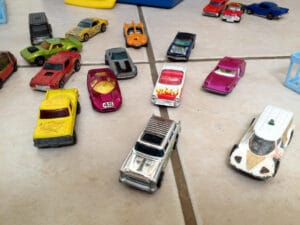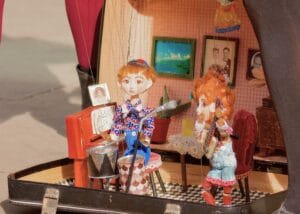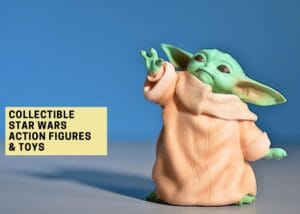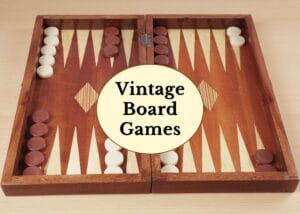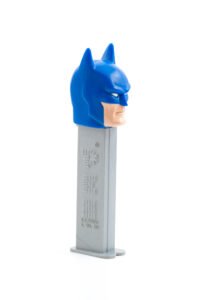Vintage toy cars have always been popular among toy lovers and collectors. And when it’s a vintage Hot Wheels car, you just cannot look away. Launched in the mid-60s, Hot Wheels revolutionized die-cast toys with speed and style, becoming a legacy!
This guide will tell you exactly which vintage Hot Wheels models are worth the most and what specific details add zeros to the price tag, and how to spot the valuable ones.
Why Are Vintage Hot Wheels Collectible?
Mattel launched Hot Wheels in 1968 and shook the toy market. Instead of realistic scale models, they focused on exaggerated “hot rod” metal designs. Their first line, the “Original Sweet Sixteen,” featured fantasy cars, like the Custom Camaro, Mustang, and others.
The most collectible period is the “Redline Era” from 1968 to 1977, known for the red stripe on the tires and the shiny Spectraflame paint. Collectors love these cars for their rarity, prototypes, limited color runs, and factory errors.
With time, Mattel introduced many other models and series. Even modern rare versions from the post-1990s era can be collectible due to their high quality over other toy cars.
14 Desirable Vintage Hot Wheels Cars to Look for
In the list below, you’ll find the 14 most desirable and iconic vintage Hot Wheels models that every toy collector is looking for. Some of these can sell for as much as $10,000!
1. Redline Aqua Custom Cougar (1967)
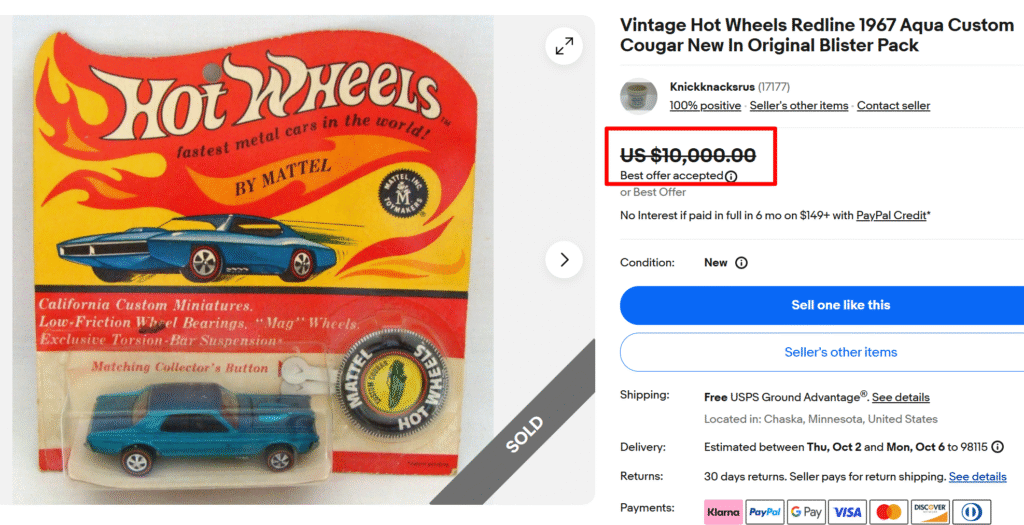
Designed by Harry Bradley, the Custom Cougar debuted as one of the original sixteen 1968 Hot Wheels. It was based on the 1967 Mercury Cougar, and featured the rare “painted tooth” variation where the center grille was painted body color on early Cougar cars.
Aqua is one of the hard-to-find colors for Custom Cougars, making this example sell for a whopping $10,000! But a huge part of this example’s high value comes from its original blister packaging with the iconic Flaming Hot Wheels card.
Collector’s Note: Look for the number “6205” and Mattel collector’s button in the original packaging for the Custom Cougars.
2. Redline Rear Loading Beach Bomb
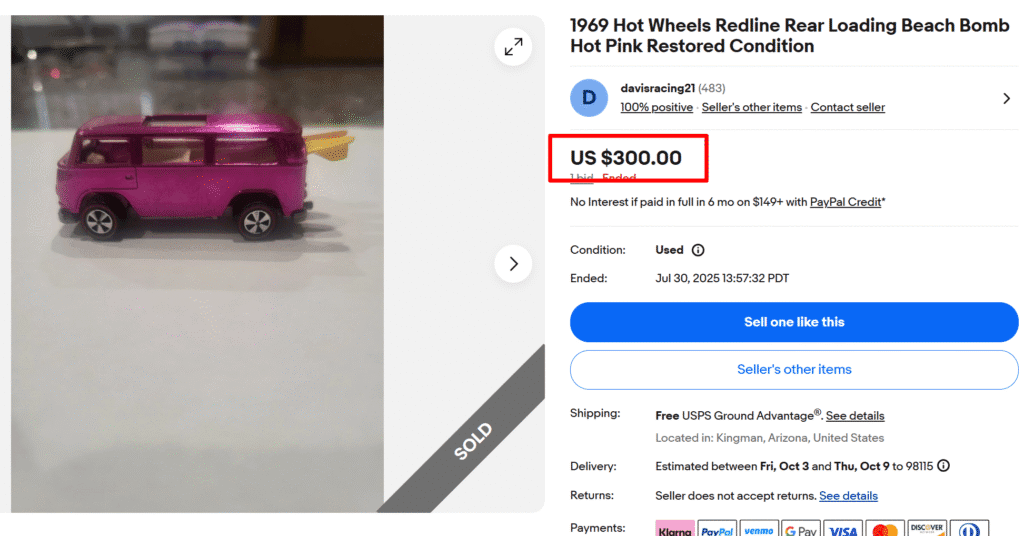
One of only two pink rear-loading Beach Bomb prototypes ever made, this is the most valuable Hot Wheels car. The original design features surfboards loading through the rear window, but it was too top-heavy and narrow for Hot Wheels tracks and accessories.
So, production stopped after only one shift at the Hong Kong factory; most parts were destroyed, and only sample pieces survived. Then the design was changed with side-loading surfboards for the production version sold to the public.
This example sold for just $300, but original pieces can sell for hundreds of thousands of dollars!
3. Grail Brown Store Display Custom Camaro
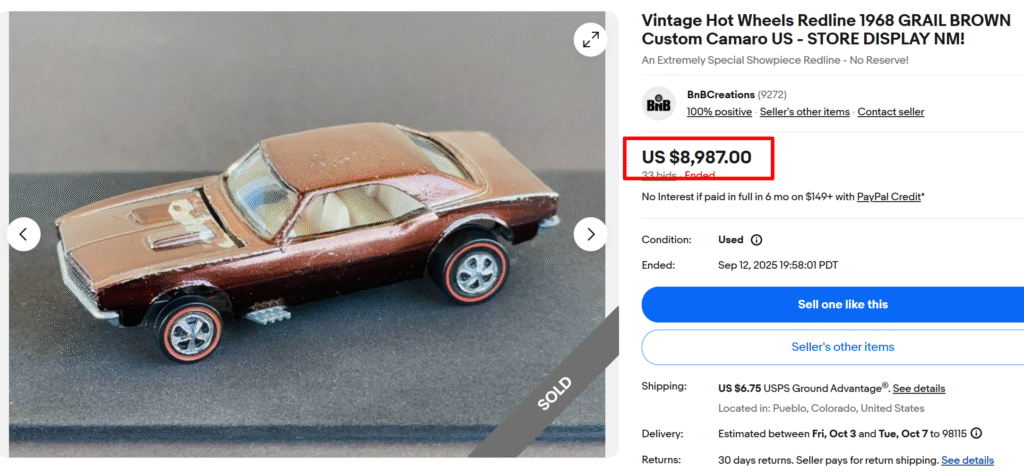
This brown-over-white Custom Camaro is rare because it was likely used for store display rather than retail sale. Also, the Custom Camaro was reportedly the very first Hot Wheels car tooled and produced in 1968 as part of the original “The Sweet Sixteen,” so it’s also historically significant, too.
After the enamel white prototype version, brown is the second rarest color for US Custom Camaros. That’s why this example sold for almost $9,000! Make sure to verify the “kidney bean” base design and the lack of door lines common in US production cars.
4. Redline Flying Colors Kind Radio Super Van (1975)
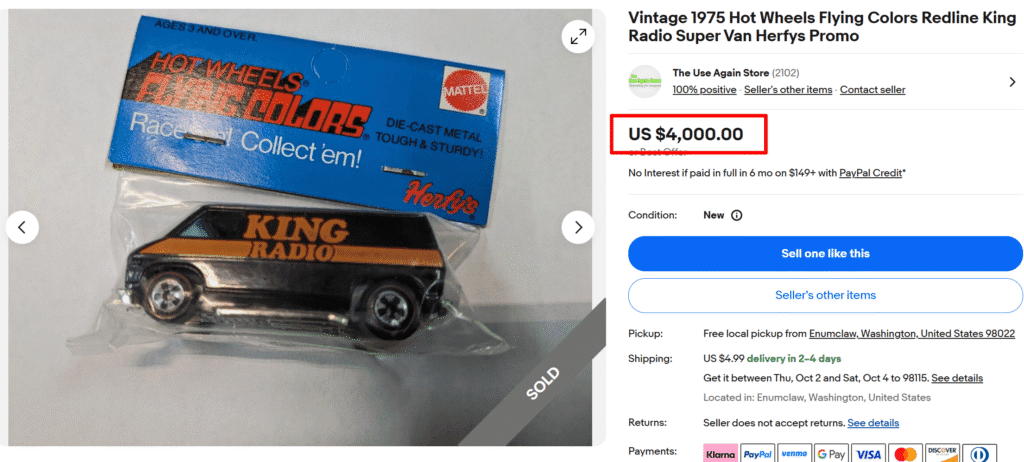
This is a promotional Super Van Mattel created for Herfy’s restaurant chain in 1975. You can easily spot it by its black enamel paint with orange “KING Radio” graphics. It was based on the popular mid-70s Chevy Van design with chrome plastic base, blue-tinted windows, and redline wheels.
Also, these were never sold in blister packs; they only came in baggies with Herfy’s header cards. Finding an original packaged example is quite difficult.
5. Redline Hot Pink Lolo Gt-70 (1968)
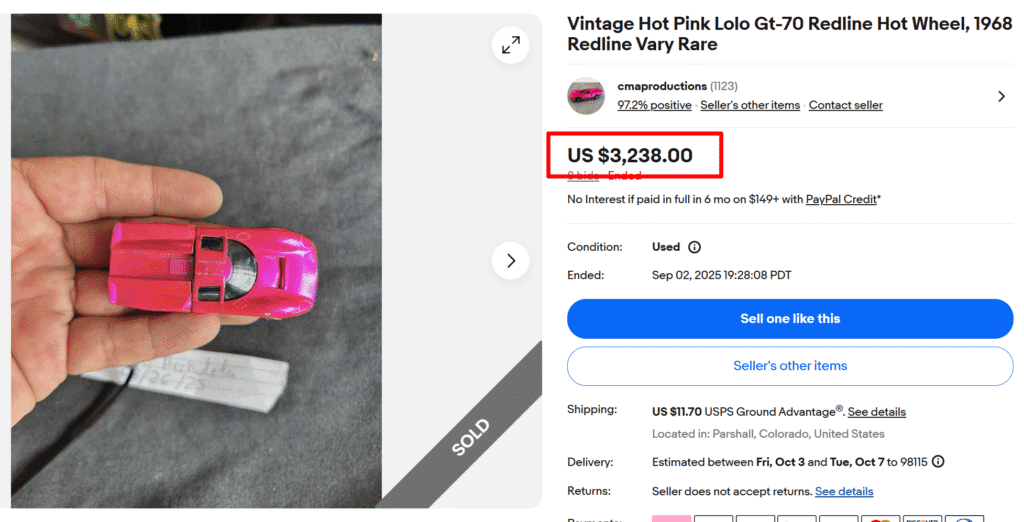
The iconic Lola GT-70 was based on the legendary Lola T70 race car that dominated 1960s CanAm and sports car racing. It was released as part of the 1969 Grand Prix Series and has an opening rear hatch with a detailed engine and a yellow racing stripe and #10 sticker.
US versions have clear glass and flat bases, while Hong Kong versions feature blue-tinted glass and four-hole bases. Second-generation colors like magenta and hot pink are very rare, making this example sell for over $3,230!
6. Redline Red Ferrari 312P (1970)
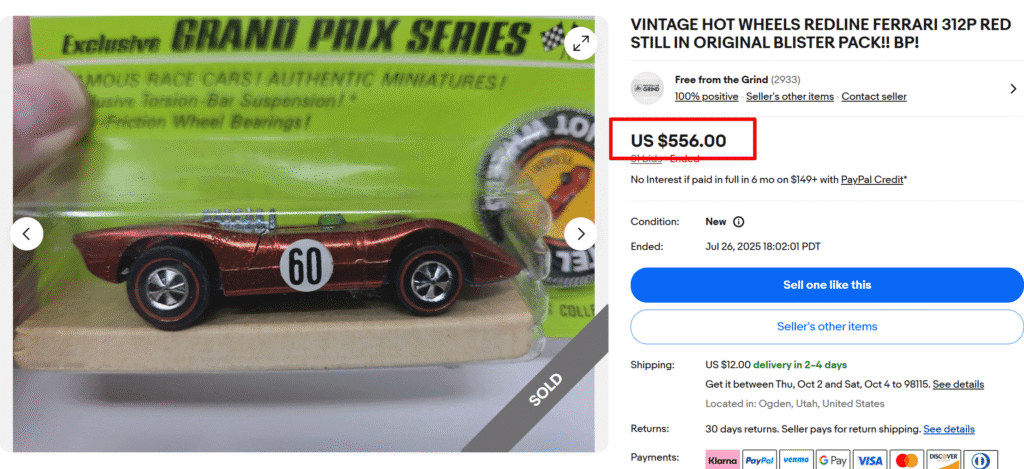
Another rare car released in 1970 as part of the Grand Prix Series. It’s a collector’s dream because it was based on Ferrari’s actual 312P prototype race car chassis #0868 that competed at Sebring and Brands Hatch in 1969!
You’ll find an opening rear hatch revealing a detailed V-12 engine, plus a #60 racing number sticker and a Ferrari prancing horse logo (sticker sheets on US versions, decals on Hong Kong versions). 312P with white interiors (instead of black) are super rare and valuable variants, selling for thousands.
7. Pink Beatnik Bandit (1968)
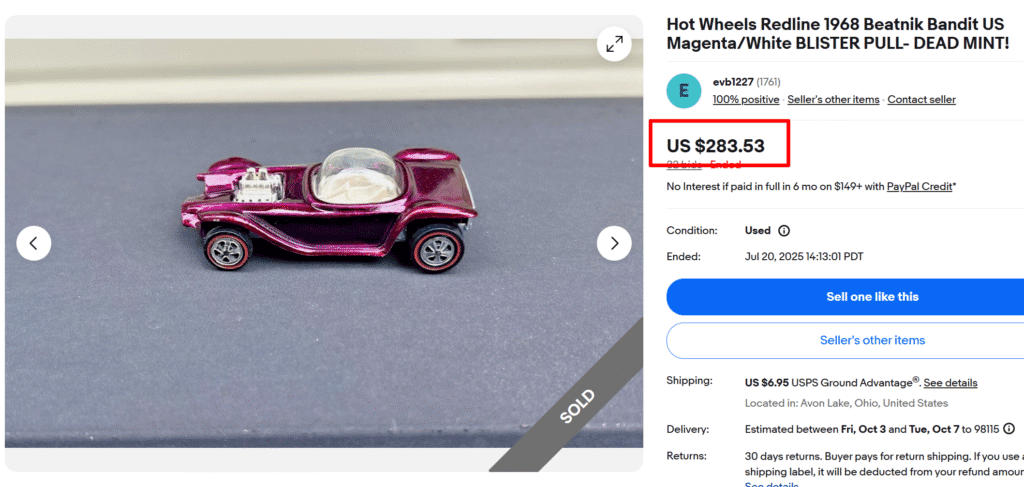
The Beatnik Bandit was one of the original “Sweet Sixteen” Hot Wheels from 1968. Known for its distinctive bubble-top canopy and fantasy show car styling, it was actually based on Ed “Big Daddy” Roth’s legendary custom car design.
This toy car was made in around 18 colors, with the ultra-rare pink being the most sought-after and valuable. Original hot pink examples can reach $4,000-$5,000 in mint condition.
Another thing to note is that the US versions have clear glass domes and control stick interiors, but Hong Kong versions have blue-tinted glass and black steering wheels.
8. Custom AMX Ed Shaver (1969)
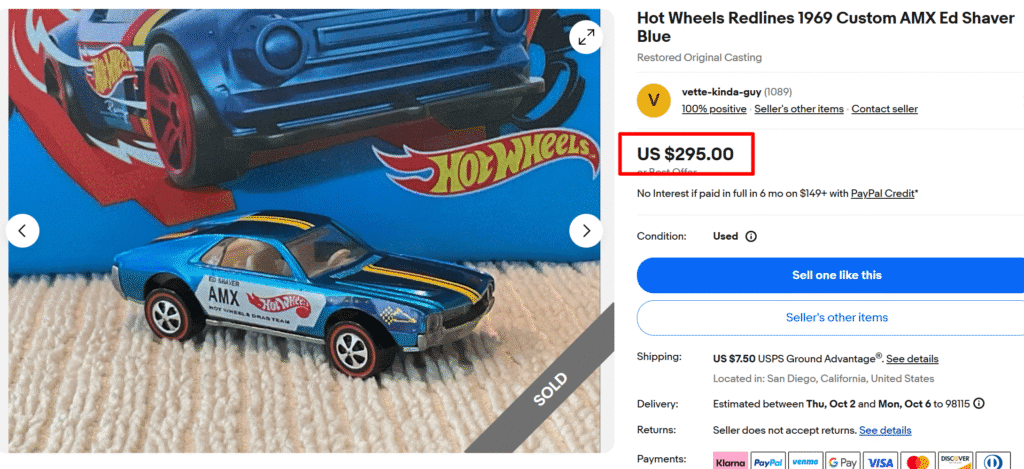
Mattel made and sold this rare UK Hot Wheels only in Britain as part of its sponsorship deal with drag racer Ed Shaver. You can easily identify this by its yellow stripe, redline wheels, and the special “AMX” and racing decals.
Ed Shaver AMX cars were distributed at racing events, through cereal mail-ins, and by sending proof-of-purchase points from UK Hot Wheels cards. Authentic examples with original packaging and decals can fetch up to several thousand dollars today.
9. Redline Bye-Focal (1971)
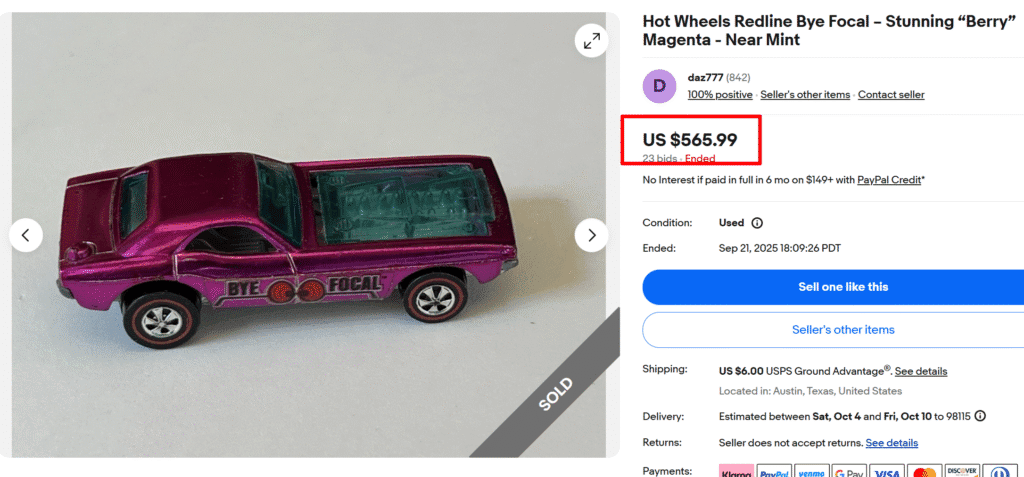
This dual-engine fantasy car was based on the 1970 Dodge Challenger. This 1971 model came with factory-applied “Bye Focal” stickers and was available in several colors, with purple and magenta being super rare. It was renamed “Show-Off” with the clear hood removed.
Bye Focal is notorious for “crumbling,” a metal fatigue issue where the body develops cracks and literally falls apart. That’s why pieces in good condition are extremely scarce to find.
10. Purple Redline Oldsmobile 442 (1971)

Many argue the 1971 Olds 442 to be the most popular casting from the Redline era, especially the purple version. The car features an opening hood with a detailed engine.
All production versions came with white interiors, while some rare red examples with black interiors may be pre-production prototypes. You’ll also find a removable black plastic spoiler and decal sheet.
This line was produced only at the Hong Kong factory in 1971, making it super rare. So, even beat-up examples hold value of hundreds. Pristine examples can go for $5,000 or more.
11. Red Baron with White Interior (1970)
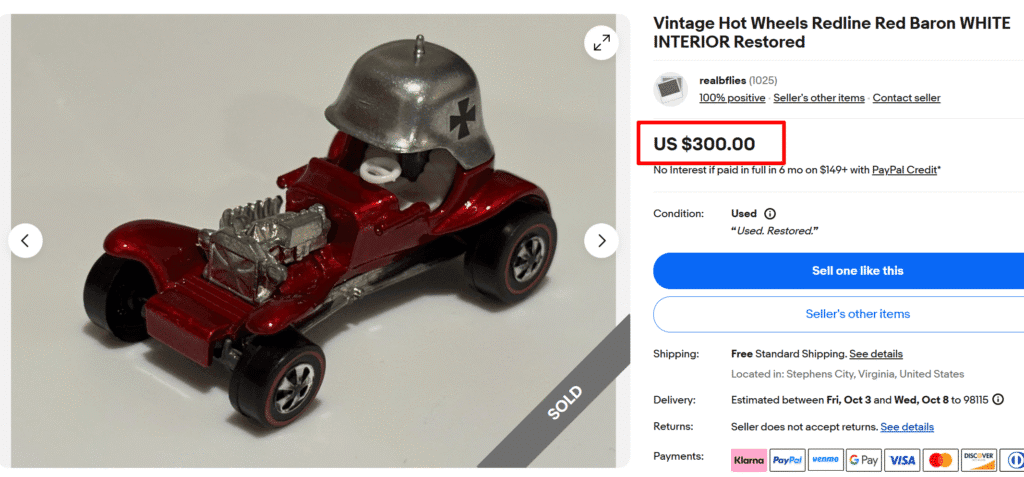
The Red Baron is one of Hot Wheels’ most popular cars, especially the early 1970s models with white interiors; these can be worth $3,000-$ 4,000. This is because only a handful of original white interior versions are known to exist; most are restored like this example.
The original 1970 model has capped redline wheels, spectraflame red paint, and a pointed spike on the helmet. Also, originals say “Hong Kong” on the base, not “China” or “Vintage.”
12. Blue Enamel Superfine Turbine (1972)
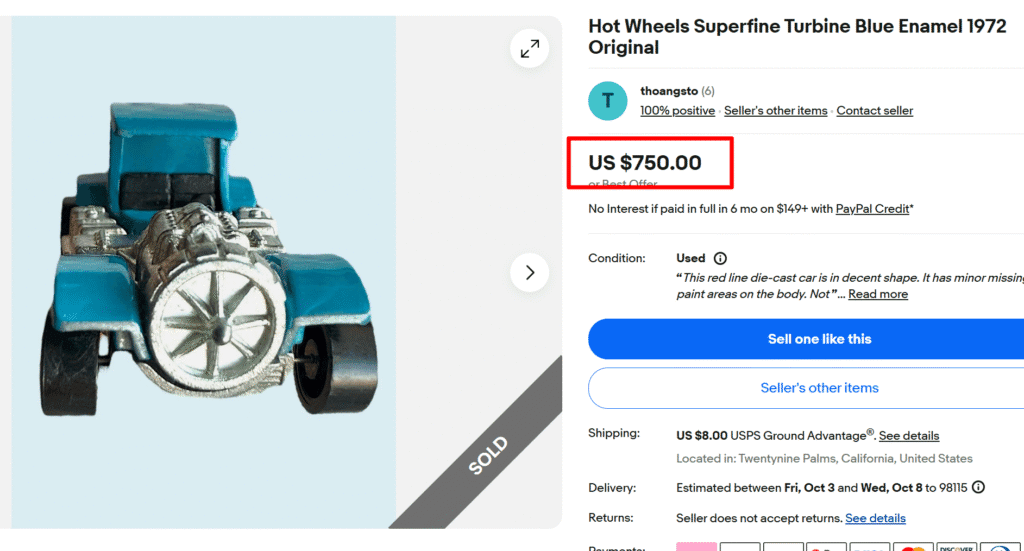
Larry Wood designed this polarizing concept car in 1973, making it one of only three new castings that year. All Hong Kong-made versions have capped wheels in the rear and open-hub wheels in front with black interiors.
Since it was produced for just one year, it’s one of the hardest-to-find redline castings. Pristine blue examples can be valued at $500 to $800, but the pink version is the most desirable of all (2,000 to $3,500+).
13. Yellow Classic ‘31 Ford Woody (1969)
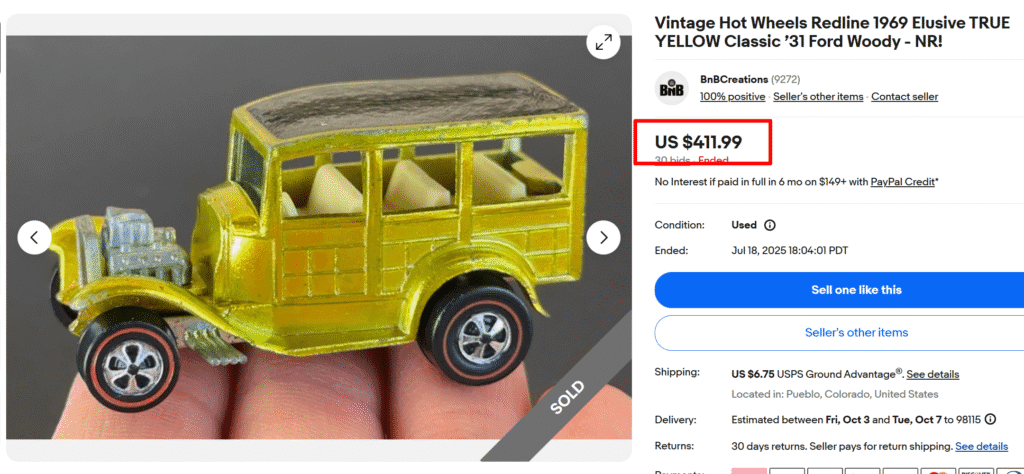
Inspired by the classic surf wagon popular on California beaches, the yellow Classic ’31 Ford Woody is also a part of Mattel’s 1969-1971 Redline production run. It was designed by Ira Gilford and produced only in the U.S.
It comes in three interior colors: white (common), dark (less common), and champagne (uncommon), all with an opening hood and clear windows.
Its ultra-rare brown version is extremely valuable, since only a few dozen are believed to exist. They can sell for $5,000 to $8,000 in mint condition. Yellow examples are much more common, fetching $200 to $500.
14. Gold & White Custom Mustang (1968)
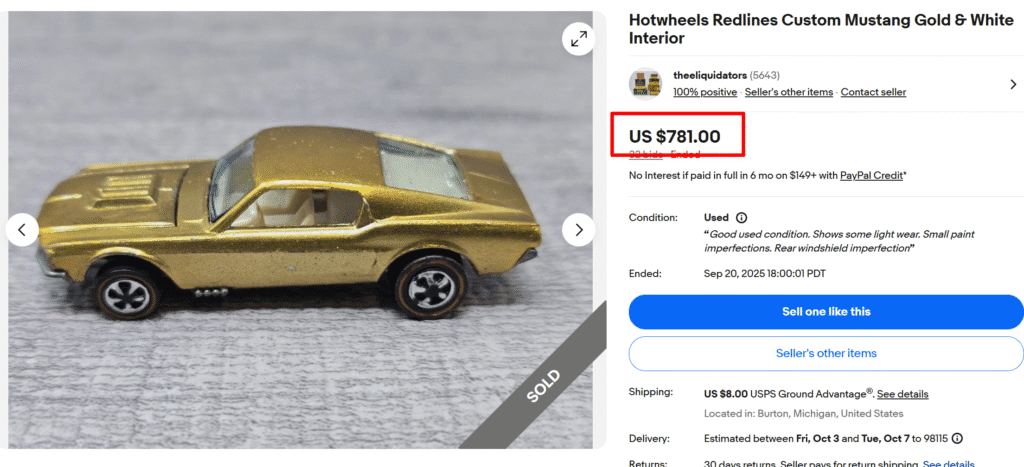
This is another iconic car from Harry Bradley’s “Sweet Sixteen” Hot Wheels series, based on the 1967 Ford Mustang Fastback. Early US versions featured white or brown interiors, clear glass, painted rear tail light panels, flat bases, and silver-painted redline wheels.
Gold and white (interior) is the most desirable combination for this car, which can fetch around $2,000 in mint condition, even more if found in blister packs. The original tool was used only on the 1968 mainline and not again until 1994, when it was re-created.
How to Know If a Hot Wheels Car is Valuable?
Evaluating a vintage Hot Wheels car’s value requires you to check its production era, unique features, and condition. The most expensive ones are the ones that are rare, brand new, and unique.
Condition and Packaging
Similar to all other collectibles, vintage Hot Wheels vehicles in good condition are worth more than those that are worn out. The value varies depending on how damaged the toy vehicle is.
Generally, a loose car (without packaging) with no scratches, dents, chips, wear, or worn-out paint (graded as “Mint”) is worth the most. Every minor chip, bent axle, or scuffed window reduces value.
Packaging also matters a lot. A car sealed on its original, undamaged cardboard backing is worth considerably more than a loose car. Collectors tend to pay more for pristine cards with no creases, price tags, or tears, and clear, undented plastic bubbles.
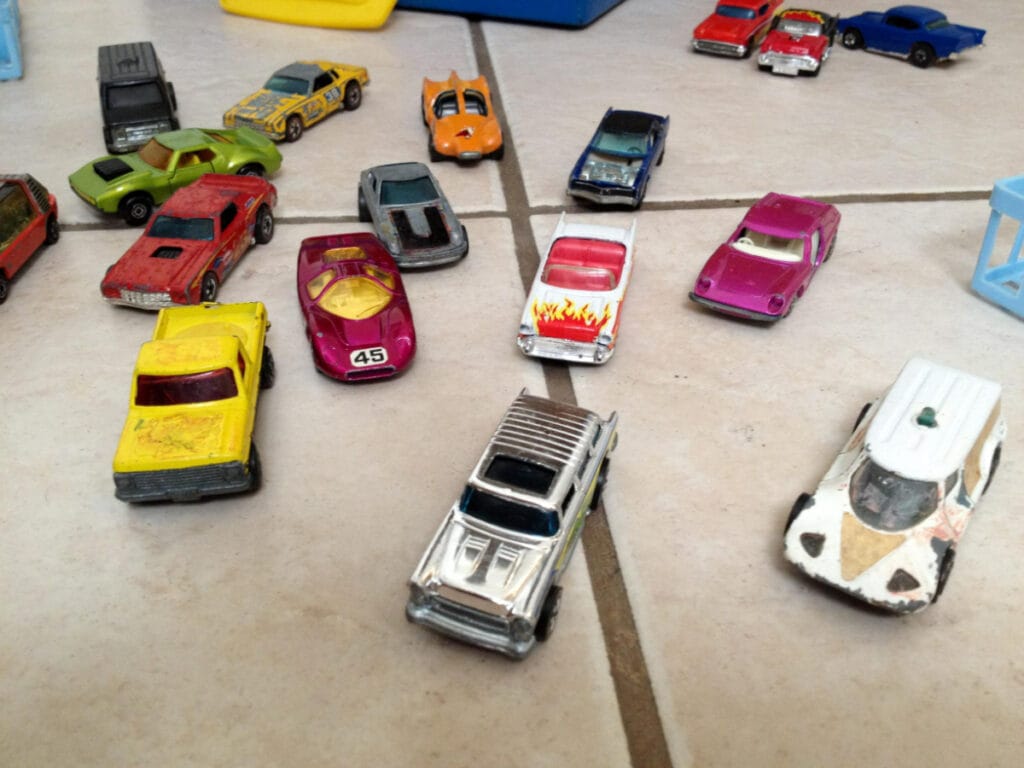
Rarity and Variations
The rarer and harder to find a Hot Wheels car, the more value it holds. Check the following features to know whether your model is rare:
- Color Variants: Some colors were produced in limited quantities and are highly desirable. Pink, magenta, or purple shades for models like the Custom Barracuda or Olds 442 are much more valuable than common colors like red, blue, or green.
- Interior Color: For certain models like the Red Baron or Rodger Dodger, a white interior instead of the common black can indicate an early, valuable production run.
- Manufacturing Errors: Some mistakes create rare versions, like mismatched parts or wheels, missing decals, or rare name castings like the original “Cheetah” stamped on what became the Python after a copyright issue.
- Prototypes: Pre-production prototypes that never made it to mass production for sale are extremely rare. The Pink Rear-Loading Volkswagen Beach Bomb is famous and can sell for six figures.
Production Era (Age)
The value of a Hot Wheels car also depends on its age; the older, the more valuable and sought-after. Matte’s first collection of 16 original castings, called the “Sweet Sixteen” (1968), includes iconic models like the Custom Camaro, Custom Mustang, and Deora.
Any toy car from this series is super collectible, especially rare color variants and packaged examples.
You can date your vintage Hot Wheels car using the following clues:
- Base Codes: This four-digit year (like ‘1968’ or ‘1970’) shows when Mattel registered the design of that casting. The car can be no older than this date, but it could have been made anytime after. But note that the same casting might be produced for decades, so a car stamped ‘1968’ could have been made in 1968 or twenty years later.
- Country of Origin Mark: From 1968 to 1972, Hot Wheels cars were made in either the U.S.A. or Hong Kong. Late Redline versions (1973-1977) came primarily from Hong Kong. After 1978, production shifted to Malaysia and later expanded to Thailand and China.
- The Wheel Type: All vintage cars from 1968 to 1977 have a distinct red stripe (Redline) on the tire groove. Wheels can be “Bearing,” “Capped,” or “Thru-Hole” style. Models from 1977 to 1994 have plain black tires (Blackwall) with no red stripe, while post-1994 versions have various wheels, like “Real Riders” with rubber-like tires.
Collector’s Tip: Redline-era cars usually have candy-colored metallic finishes called “Spectraflame” paint. It looks far more vibrant than the enamel paint used later.
Note: This article is intended for informational, educational, and entertainment purposes only. Some images are illustrative and may not represent actual brands, products, or related entities. All trademarks, product names, brand logos, packaging, and other intellectual property referenced remain the exclusive property of their respective owners. Any brand mentions or references are provided solely for descriptive and educational context and do not imply any formal or commercial association.

